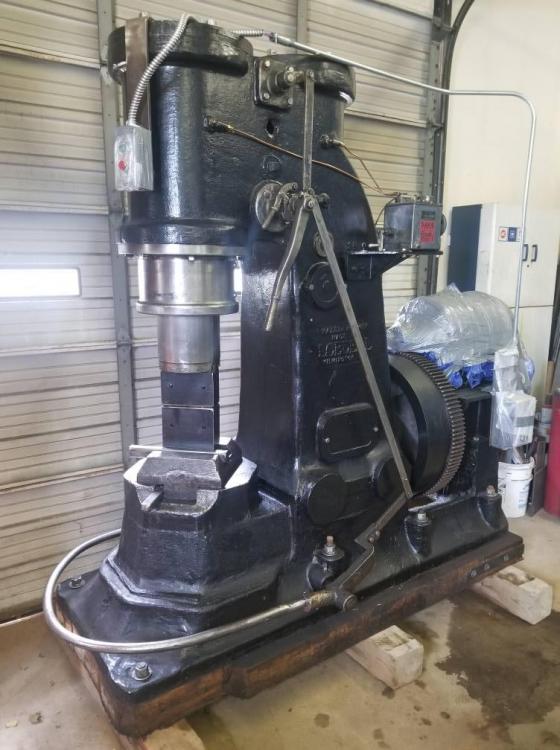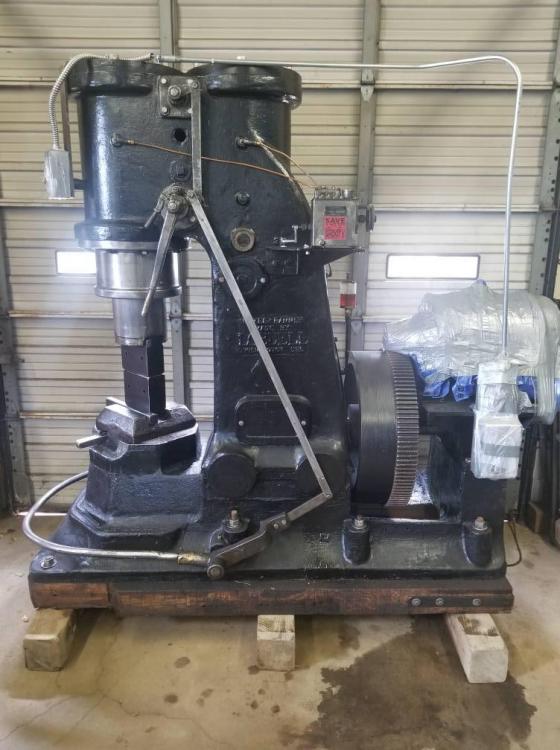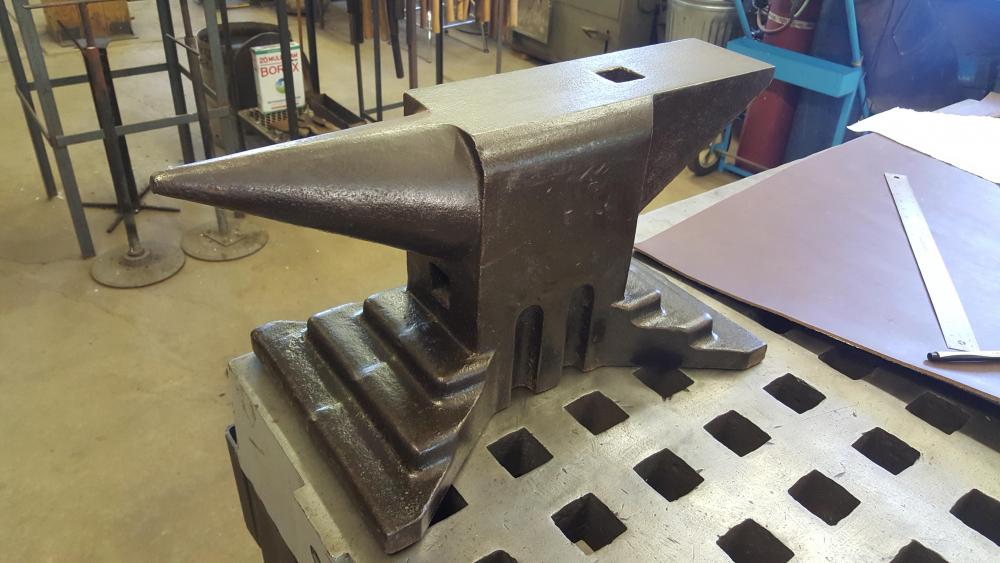
griffinforge
Members-
Posts
79 -
Joined
-
Last visited
Content Type
Profiles
Forums
Articles
Gallery
Downloads
Events
Everything posted by griffinforge
-
So I’m the very proud new owner of this amazing 1piece Nazel 3B. Took me many years to find the right hammer to compliment my 1B to do the big work at the forge. I do wonder how many of the 1 piece hammers are out there, I only know of a handful of 1 pc 3B’s.
-
It's not a JEB anvil I'm pretty sure, the feet have a wider stance than that style anvil, in the second picture is the serial number stamped on the side 41558.
-
Recently purchased this 80kg Austrian anvil in almost perfect condition. The rebound and ring are amazing. Next step is to find out approximately how old it is based on the serial #41558. Anyone with any insight please feel free to chime in.
-
Thanks for posting Gray Iron!
-
Just purchased and refreshed this really nice Quickwerks vice. It has all its original hardware and the jaws measure 5 3/4". It curiously has a much deeper throat from the screw to the jaws than most vises (about 6 1/2", my other vises this size are 4") and I'm wondering if this is common for this style vise?
-
For the record this vise stands at the same height as my other leg vises, around 38"or 40" I believe. The other 8" vises I have seen only had stubs for legs on them as well, the "leg" on this one is only about 3 1/2" long.
-
I finished with a wire wheel and coated in a beeswax/linseed/turp mixture, the screw is 1 3/4" and 3 tpi.
-
It's a bit over 2 ft. long and made from 1" round bar.
-
Finished restoring this big vise, took a long time to find one this size. Jaws are 8 3/8" and it weighs in at about 210lbs.
-
I'd like to build some thing essentially like a pipe threading machine with a gear reducer, mounting to a beam sounds reasonable..I have an acorn table I could mount it to as well. And yes I do have a 14 x 40 lathe that I was contemplating for this application. Thanks all for the input!
-
Anyone have plans for a bar twister before I start engineering my own plans .. I'm looking to hot twist 1" to 2" bars in max 1' sections.
-
500 lb Bradley-Not!!
griffinforge replied to patrick's topic in Power Hammers, Treadle Hammers, Olivers
Pulled the ram on my 100 Strap this spring and it weiged in at 158lbs. -
1,000 weight niles bement pond hammer
griffinforge replied to Ric Furrer's topic in Power Hammers, Treadle Hammers, Olivers
Congrats Ric, that's quite the hammer. -
Buying a Bradley
griffinforge replied to Andrew.V's topic in Power Hammers, Treadle Hammers, Olivers
I have a 100 Bradley Strap Hammer that I finished restoring a year ago. It was nowhere near as worn as yours and it took me well over a year to restore it in my own blacksmith/fab/machine shop. Its not an impossible job, but its going to take ALOT of time and money to make it happen. Access to a similar hammer could be of some help if you know of one in your area. Best of luck to you, they're great hammers. -
What type of power hammer do you use?
griffinforge replied to EWCTool's topic in Power Hammers, Treadle Hammers, Olivers
100lb. Bradley Strap Hammer. -
Congrats, that's a great score!
-
I did get in touch with Ric, he gave me the info i needed. Ive got another bar of the bloomery steel to mess around with along with a paper cup full of smaller pieces of the bloom that I'm in the process of consolidating, which will be my "test subject" to experiment on. Thanks for the info Thomas, I'm curious to see what I come up with after a few heat treating variations.
-
So I'm moving into new territory on this one. I forged a saxon style 4 bar billet, consisting of a cutting edge which is bloomery steel I made a Ric Furrers smelting class, and 3 bars of wrought iron. My questions are how different is the normalization process from damascus made of 1084/15n20, and how do I go about hardening/tempering? The bloomery steel is about medium carbon steel judging by the spark trail. Rusty
-
Iron Smelting with Ric Furrer
griffinforge replied to griffinforge's topic in Smelting, Melting, Foundry, and Casting
Ric, So far I did the final straightening of the blade and did the rough grind of the profile, I should have it looking like a cutting tool soon enough. I'm gonna contact you some time soon for some plans for that hydraulic press we discussed. -
Iron Smelting with Ric Furrer
griffinforge posted a topic in Smelting, Melting, Foundry, and Casting
I took part in the Iron Smelting class at NESM in Auburn ME last week. The week long class was taught by Ric Furrer, and the objective was to build and run two smelters in the Viking and Japanese style. By the end of the week we had two successfully smelted blooms and had enough time to refine them into bars, which in turn were forged into knives. Thanks to Ric for sharing his knowledge of the process and to Dereck Glazer who runs the show at NESM. A few shots of the process...my apologies for the photo sizes. -
Great looking axe!
-
Bradley hammer project
griffinforge replied to griffinforge's topic in Power Hammers, Treadle Hammers, Olivers
Patrick, Thanks for the info, I've set my hammer on the longest stroke possible and its seems to me so far that's where it will stay. I'll try adjusting the point of impact next and make the necessary adjustments from there. The cushions that came on the machine are not new, but still in good shape and the tension is good. (The machine came with a new set of cushions as well) I'll be using the machine to work varying material thicknesses from damascus billets to small round bar, so I'm sure I will need to make adjustments regularly. Thanks again for the help. -
Bradley hammer project
griffinforge replied to griffinforge's topic in Power Hammers, Treadle Hammers, Olivers
Thanks all for the compliments, Danger I checked out the info you sent and it was as I figured, after turning the flywheel half a dozen turns the eccentric loosened up and ive been able to move it freely and set it where I want it at this point. Ill send a PM later, as I would like to read up on the fine control adjustment among other things. I'm sure I'll have to make adjustments as I use the machine. I'm cooking up a billet right now and I'm pleased with the performance so far.... thanks again!


